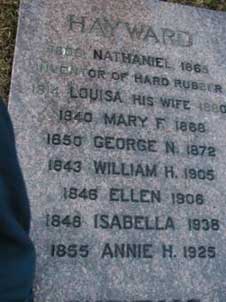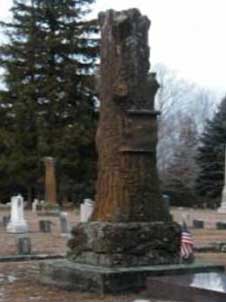|
If you have come to this page from a search engine please click here for a full site map and access to all site pages
The 19th century industrial expansion throughout eastern America was no more evident than in the Massachusetts/Connecticut areas and here we find our first reference to Nathaniel Hayward, where he was working for the Eagle Rubber Company in the 1830’s. The firm was not successful and in 1838 Hayward took it over himself. It was he who interested Goodyear in rubber/sulphur mixes when they met at Eagle Rubber, now located in Woburn, Massachusetts where it had moved to from Easton, Pennsylvania in 1838. Hayward had discovered that dusting rubber sheets with sulphur, or painting the surfaces of the sheets with solutions of sulphur in turpentine and exposing them to sunlight (a process he called "solarisation") “causes the gum to dry more perfectly and to improve the whole substance thereof rendering it much superior to that prepared by any other combination therewith”. This he patented in 1838 (US Patent 1090 granted 1839) and immediately assigned to Goodyear. Apparently he did not make a success of his company as he soon turned the factory itself over to Goodyear and agreed to work for him there. Ironically the first person to take out a license to manufacture rubber goods under Goodyear's vulcanization patent was Hayward but he soon transferred this to Gandee and Steele of New Haven, Connecticut in 1843 and their company went on to become part of the United States Rubber Co. in 1892. In 1844 Hayward and Burr established the Hayward Rubber Company at Lisbon, Connecticut. From here rubber products, boots, and shoes were shipped all over the country and, although Hayward retired in 1864 because of ill health, the company thrived until 1893 when it was closed and later the building burned to the ground. In the centre of this region (about 60 miles north east of new York) is the rural settlement of Colchester which was founded in 1698. In 1706, the first street was laid out and by 1714, there were some 50 families in town. By 1756 Colchester was one of the most thriving rural towns in the Colony. Its population was recorded as 2,300 inhabitants and by 1782 had grown to 3,300. This small town, today with a population of around 10,000, has a unique place in the history of rubber. In the churchyard is a tombstone and memorial to Hayward, the latter in the shape of a 10ft high concrete rubber tree trunk whilst the former identifies him as the inventor of hard rubber: This claim appears tenuous. Leuchs in Germany had probably made hard rubber (ebonite, vulcanite) in 1831 but had not realised what he had done whilst the work of Ludersdorf mirrored but preceded that of Hayward. The most valid claim is probably the patent by Hancock (BP9952/1843) which described a horn-like material which resulted from heating rubber in molten sulphur for several hours at 155-160C. Hancock realised he had a useful material! Nevertheless, Hayward does have every right to a memorial identifying his role in bringing together Goodyear, rubber and sulphur; a combination without which the industrial revolution would have ground to a halt very quickly (but check out the importance (?) of Mr Eli!). |





